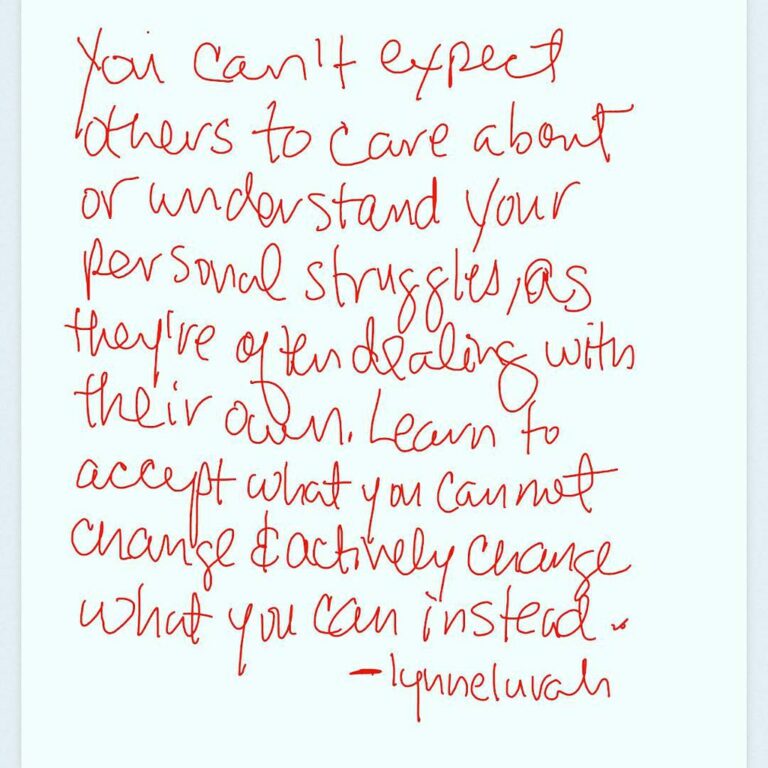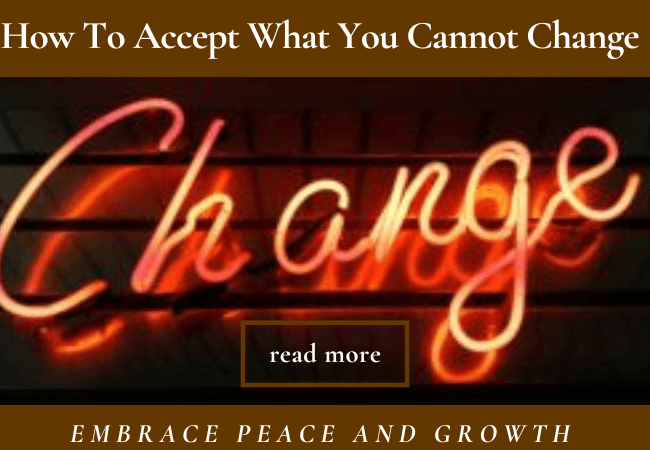How To Accept What You Cannot Change

You cannot change the past. You can only experience the present moment. The future must be crafted the way you want. -Sadhguru
Ever since the death of my father and husband back-to-back. The changes my family and I have gone through from 2018 to the present. Has my mind spent, to say the least.
I’ve been on this journey of accepting all that has happened. And it hasn’t been easy. It is not for the faint at heart.
Learning how to accept what you cannot change is something every human being will need to know. To survive this that we know as life on earth or in the physical realm.
I have so many different feelings and emotions. I don’t know sometimes if I’m ok for real or not.
I can best describe my current state as I’m ok but I’m not. I’m trying to accept the things I cannot change. And it has been a challenge.
Emotions and feelings are all traits we share as humans. Understanding how emotions and feelings can cause us to struggle in the life department of accepting what we cannot change. It is the key to getting us to accept what we cannot change.
Let’s explore for a moment what emotions and feelings are to us. In other words, what’s really going on?
What Are Emotions?
Emotions are associated with physical reactions that are activated through neurotransmitters and hormones. Released by the brain.
What Are Feelings?
Feelings are the conscious experience of emotional reactions. Originating in the neocortical regions of the brain.
Feelings are sparked by emotions and shaped by individual experiences. Beliefs, memories, and thoughts are linked to that emotion.
A feeling is the side product of your brain. Perceiving an emotion and assigning a certain meaning to it.
What Is the Difference Between Feelings and Emotions?
A fundamental difference between feelings and emotions is that feelings are experienced consciously.
While emotions manifest either consciously or subconsciously.
Some people may spend years or even a lifetime. Not understanding the depths of their emotions.
Understanding the depth of our emotions and feelings can lead us on the path to acceptance.
Can You Choose Your Emotions?
So, the short answer is no, you cannot “control” your emotions. But if you follow the strategies to accept your emotions as they come. You will find that you do not have to let your emotions control you.
Is It Wrong to Feel Emotions?
Feeling our emotions is quite different from allowing them to rule our behavior.
When we allow ourselves to feel even our most unacceptable feelings. In a safe and healthy forum, we’re less likely to act on them in destructive ways.
It’s possible to feel hurt without acting victimized. And to feel anger without lashing out.
We often allow these two elements to rule our very existence. Cause us to be stagnant where we should have moved on.
Keeping us from progressing and living life to its fullest.
Why Is Change in Life So Difficult?
Change is difficult as we get older because we create cocoons of comfort. We are looking for safety.
The more security-oriented you are. The more disturbed you will be with every change that happens in your life.
The essence of physical existence is changing. Everything is changing. Is there anything that isn’t changing?
Everything in existence is changing. The very essence of physical reality has changed. Nothing is constant.
Everything has changed. When you resist change you are resisting the very process of life. Not just your life.
You are resisting the complete process of life. And you will create unnecessary suffering in your life as a result.
Once you resist changing depression is a natural process. Frustration and depression are the best of the devil’s tools.
They will cause you to work against yourself. Frustration
evolves into depression when you resist change.
Being depressed and frustrated with life can bring on suicidal thoughts. Some people act on those feelings and emotions. And some of us do not.
Changing the way, you think about what it is you can’t change. It is going to be the answer to changing those feelings and emotions. That will come.
Sometimes we have no control over when they appear. We can’t change that either. We can only change how we choose to accept what is now different in our life.
Although everyone has experienced depression in some form. But some can’t change the fact that their depression is a result of a medical condition.
Accepting this change. Can help those who struggle with depression and anxiety medically. Better manage their situation in a healthier manner.
My Aha Moment!
Because I clearly woke up like this. I wanted to understand more about the Serenity Prayer.
In my thirst for serenity in my situation. The origin of the word was what I was after. The state of being calm, peaceful, and untroubled.
I found myself speaking aloud the first line of the prayer that says,
“God, give me the grace to accept with serenity the things that cannot be changed,”

And then I looked up the entire prayer… and it reads
“God, give me the grace to accept with serenity
the things that cannot be changed,
Courage to change things
which should be changed,
and the Wisdom to distinguish
the one from the other.
Living one day at a time,
Enjoying one moment at a time,
Accepting hardship as a pathway to peace,
Taking, as Jesus did,
This sinful world as it is,
Not as I would have it,
Trusting that You will make all things right,
If I surrender to Your will,
So that I may be happy in this life,
And supremely happy with You forever in the next.”
Amen.
It sounds so easy. But it isn’t easy to accept what we cannot change. Why is that? The prayer left me with more questions.
What's Wrong with the Serenity Prayer?
The problem with the Serenity Prayer. Is that it creates an either/or, black-and-white contradiction.
As if all the situations and challenges that a person is confronted by. Can be placed into one or the other bucket.
If you’re in a troubled marriage or a terrible job—or a fusion of both. Saying “I can’t change this” as in the Serenity Prayer leads you down the road of self-destruction.
Of course, it makes sense to accept the things that we cannot change. But how do we know if a particular situation is truly unchangeable, cast in stone?
Given the near-infinite complexity of the world and of human relationships. does it really make sense for people, to be encouraged to make such absolute decisions? I don’t think so.
Our chronological trends about the way that we think and act in the world.
Can always be incrementally adjusted or adapted. To approach purposely or naively something as either black or white. It is setting the stage for important missed opportunities.
Like forgiveness and reconciliation.
Think of it as a light switch. There is the old-fashioned on and off switch, which is consistent with the Serenity Prayer.
And then there is the dimmer switch, which tones up or tones down the lighting in any room.
The Serenity Prayer should therefore not be looked at as “either-or.” “black-and-white,” “yes or no,” “right or wrong,”
But in a way that accepts that all most everything. Can be modified or adapted to a degree, even if it’s not complete.
We can change everything, and it is important that you don’t throw your hands up and say you’re powerless. Before you have even put up any real effort.
If the reality is that you are only able to change something to a degree. It is not helpful in your healing process to minimize incremental growth and change.
Healing is a process of incremental change. And as we change, things that may have before seemed impossible to change. Can and should be examined with fresh eyes.
Things can be changed to a degree. Yes, there are things that cannot be changed, such as what time the sun comes up or the law of gravity. And the real tough one. Death!
ESPECIALLY DEATH! We cannot change that. We must simply accept it and move on. And it is a process.
It also requires the human spirit to be willing to accept what you cannot change.
We must accept that death is a process of life. There is a time and a season under the sun for everything.
A time to be born and a time to die! We must accept that reality when we lose our loved ones.
But in many situations, especially when you’re dealing with yourself or another living human being. Can be modified.
We should not throw our hands up and say, “It can’t be changed,” give up and stop trying. The truth is we can change our behavior without changing it 100%.
We all have the power to change anything!
Life is all about these incremental modifications. Without you are missing a vast array of options. That may be present beneath the surface of a situation.
It is nonsense to tell someone they can’t improve upon and influence their behaviors.
We mustn’t feel stuck and not give credence to the truth that we all as human beings are free. And can change most of our behaviors.
When you are told that you cannot change something. You can get depressed, become oppositional, or feel hopeless.
The black-and-white mentality within the Serenity Prayer. Leaves no room for modification, experimentation, or nuance. Life isn’t that way.
It is about discovering and understanding the many hidden colors. Between the black and the white.
The array of options can lead us to creative progress. Empowerment and self-discovery.
How Do You Accept the Things You Cannot Change?
Spend time reflecting on the things that you can do better because of the new change in your life.
Find purpose in how you live moving forward. That’s how you can not only accept what can no longer be changed. But also benefit from it in the future.
ACCEPTANCE IS FREEDOM!

Why Is Acceptance Freedom?
Within yourself, you must come to a total acceptance of everything.
You only have 24 hours to come to a total acceptance of everything.
Your mental things, emotional things, body things. Relationship things, social things, every damn thing.
Just simply accept it as it is. You don’t have to do anything with anybody. Just within yourself. If you do this. Life will happen on a larger scale.
Life will give you the true meaning of the pain you endured. The loss or the change that you are experiencing.
It all has a purpose and will be revealed at its appointed time.
Until that appointed time. Whatever you do be open to the idea of accepting what really can’t be changed and really change the things that can. Starting within.
I would love to hear your thoughts on how to accept what you cannot change. Leave your comments in the comment section.
Subscribe to my blog here! And follow me on social media!




This article on embracing acceptance to foster peace and growth really resonates with the challenges many face when dealing with change and uncertainty. Your reflections on the journey of acceptance, especially relating to loss and emotional resilience, are powerful. A few questions come to mind that could deepen the understanding of this topic:
1. How can someone distinguish between situations they truly cannot change and those they might have some influence over? I find this distinction crucial yet sometimes difficult to discern, especially in complex relationships or long-standing habits.
2. The concept of acceptance contributing to physical health is fascinating. Could you elaborate on how this mind-body connection works? Are there specific studies or practices that have shown a direct impact on physical well-being through acceptance?
3. Regarding the Serenity Prayer’s perspective, I appreciate your insight on seeing it not as “black-and-white” but rather with nuance. How would you suggest reframing situations where “acceptance” feels like a defeat rather than a path to growth?
Your approach provides a fresh, nuanced take on acceptance as a source of empowerment rather than resignation. Thank you for this inspiring read—it certainly prompts reflection on how embracing acceptance can lead to a more balanced and resilient life.
Thank you so much for your thoughtful comment and profound reflections, Amalthe! I’m glad the article resonated with you and offered fresh insights on acceptance as an empowering process. You’ve raised excellent questions; I’d love to dive into them!
Amalthe, your role in this process is crucial. It’s a delicate balance, and you navigate it with grace. A helpful approach is to assess if any small action could realistically shift the outcome. For complex relationships, this might mean asking, “Can I influence this person’s response, or is my role more about setting boundaries and expectations?” With ingrained habits, it helps to focus on small, incremental steps rather than total control, which can be freeing. Journaling or seeking outside perspectives can sometimes clarify what’s within our reach versus what we may need to release.Acceptance and Physical Health: The mind-body connection is indeed powerful. Studies have shown that acceptance practices—like mindfulness and stress management—can reduce physical markers of stress, such as cortisol levels, positively impacting immune function, heart health, and even pain perception. Practices like mindfulness meditation, which emphasizes acceptance of thoughts and sensations, directly benefit physical well-being. Regularly embracing acceptance can also help lower chronic stress, which has ripple effects on overall health.Reframing Acceptance as Growth, Not Defeat: Reframing it as a conscious choice can help when acceptance feels like defeat. For example, shifting from “I have to accept this” to “I choose to accept this as part of my growth process” changes the tone from passive resignation to active empowerment. It’s about recognizing that acceptance is a step toward inner freedom, freeing up energy to invest in things we can control. This reframing can also help us see acceptance as a practice that builds resilience rather than weakness.
Thank you again, Amalthe, for your invaluable contribution to this discussion. Your insights have added depth and richness to our exploration of these nuanced approaches to growth. I’m so glad this article encouraged reflection, and I’m here if you have more questions!
Warmly,
Jamie